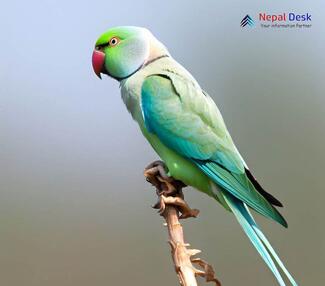The Alexandrine Parakeet, also known as Psittacula eupatria, is a medium-sized parrot hailing from the Indian subcontinent and Southeast Asia. Beloved as pets for their intelligence, striking looks, and ability to mimic human speech, these birds have much to offer.
These parakeets have a unique social habit of forming large groups in trees or buildings for both sleep and interaction. Playfulness is abundant in their behavior—expect to see them hanging upside down and fiddling with objects.
As strong fliers, Alexandrine Parakeets can soar for extended periods of time. They can reach impressive heights and cover great distances during their flights.
In their natural environment, these parakeets play an essential role in seed dispersal and pollination. They are preyed upon by various predators that help maintain the balance within the ecosystem.
It's not hard to identify Alexandrine Parakeets by their distinct green feathers, vivid red beak, and maroon shoulder patch. With a length of around 60 cm from head to tail, these parrots are relatively large.
Their habitat spans across the Indian subcontinent and Southeast Asia, covering countries such as India, Bangladesh, Nepal, Bhutan, Myanmar, Thailand, Laos, Cambodia, and Vietnam. These birds prefer forested regions and are frequently seen in large groups.
The Alexandrine Parakeet is a fascinating species with both stunning features and ecological significance. Their distinctive behaviors and flying skills make them enjoyable to watch as pets or in their natural surroundings.
They typically nest in tree cavities or crevices but will sometimes use man-made structures. Nests are lined with soft materials like wood chips. In-flight acrobatics such as looping and other aerial tricks are common sights.
During mating season, devoted pairs engage in affectionate rituals like taking care of each other's grooming needs and sharing food. They fiercely defend their nesting territory from intruders. Generally, 2-4 eggs are laid per clutch, and incubation lasts for around 23-24 days.
Their diet primarily comprises seeds, fruits, and plant matter, classifying them as mostly herbivorous. Seen foraging in large groups, their strong beaks come in handy to crack open tough nuts and seeds.
Differences between males and females are subtle; size and tail length are the main identifiers. They share a strong bond with their partners and indulge in mutual grooming and feeding behaviors.
While they don't migrate long distances, they may travel short distances in response to changes in food availability or nesting sites.
In Nepal, Alexandrine Parakeets can be found in forested areas across the country, from the Terai lowlands to the Himalayan foothills. They have also adapted well to urban areas like parks and gardens. Birdwatchers can often spot them at Chitwan National Park, Bardia National Park, and Koshi Tappu Wildlife Reserve.
During courtship and breeding periods, males tend to be more vocal and active than females; however, they both share similar physical traits—green plumage and red beaks.
The Rose-ringed Parakeet (Psittacula krameri) is often confused with Alexandrine Parakeets due to similarities but has a smaller body size and a more restricted range.
The best time to observe Alexandrine Parakeets is during the dry season from October to April when they're more active and visible. These birds are often seen around fruiting trees in tree canopies or urban locations where they have adapted well to humans.
At the moment, the International Union for Conservation of Nature (IUCN) considers the Alexandrine Parakeet as a "Least Concern" species, meaning it is not facing immediate extinction. However, issues like loss of habitat and being hunted for the pet industry could still jeopardize their existence.
In Nepal, Alexandrine Parakeets are typically seen in forested areas, particularly in the Terai lowlands and near the base of the Himalayas. These charming birds are often found perched on tall trees or foraging for food in fields and gardens. To witness these magnificent creatures up close, Chitwan National Park and Bardia National Park are perfect places to visit, since they offer diverse habitats where Alexandrine Parakeets flourish.




